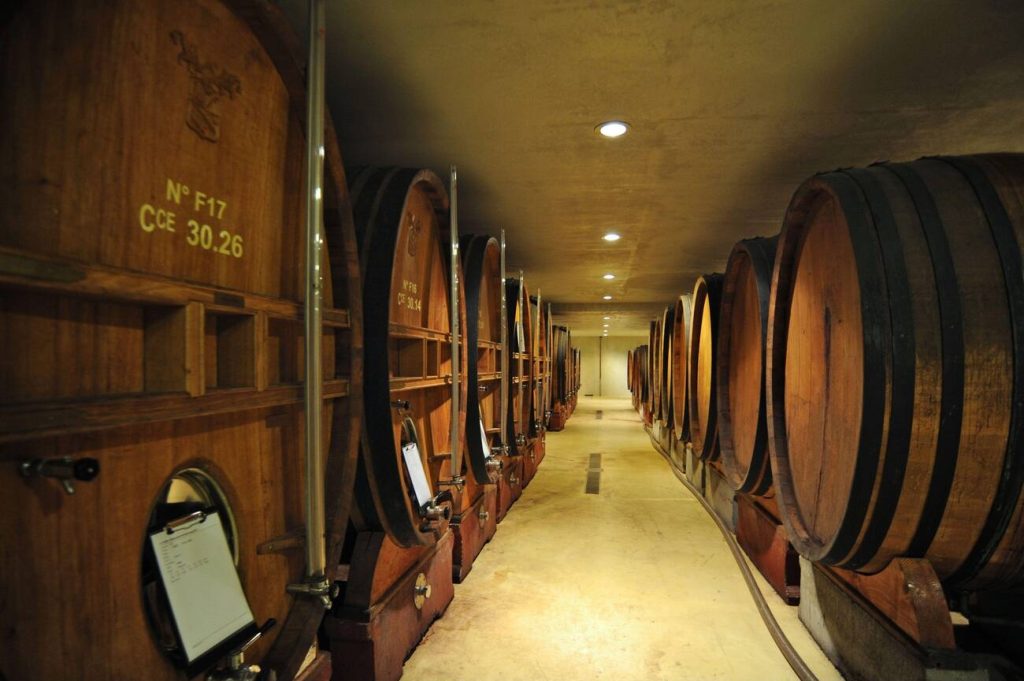Are you unsure of how long to store your red wine in the cellar? Well, fear not! This handy guide is here to help. Many people believe that red wine improves with age, and they’re not wrong. But how do you know when it’s time to pop open that bottle? In this article, we’ll explore the factors that affect red wine aging and provide tips for proper storage. So sit back, relax, and get ready to become a cellar connoisseur!
Contents
- Factors Affecting Red Wine Aging
- Optimal Temperature for Red Wine Storage
- Importance of Protecting Red Wine From Light
- Maintaining Proper Humidity Levels for Red Wine
- The Impact of Vibrations on Red Wine
- Essential Wine Preservation and Storage Accessories
- Storing Red Wine After Opening: How Long Does It Last
- Tips for Proper Red Wine Storage
- Common Mistakes to Avoid When Storing Red Wine
- Long-Lasting Red Wines: Regions and Price Factors
Factors Affecting Red Wine Aging
Factors such as sugar content, acidity, tannin composition, and alcohol level can affect how long red wine ages. These factors play a crucial role in determining the aging potential of red wines. The higher the sugar content, acidity, and tannins, along with lower alcohol levels, the longer a red wine can age. Additionally, proper storage conditions are essential for preserving the quality of red wine over time. Maintaining an optimal temperature between 14 to 18 degrees Celsius is crucial for red wine storage. Protecting red wine from light exposure is also important as direct sunlight can negatively impact its flavor and longevity. Proper humidity levels between 50-70% should be maintained to prevent cork damage or spoilage due to excess moisture. Lastly, vibrations should be minimized as they can disrupt the aging process of red wine. By considering these factors and providing suitable storage conditions, you can ensure that your red wine ages gracefully and develops complex flavors over time.
Optimal Temperature for Red Wine Storage
To ensure the best storage conditions for your red wine, it’s important to maintain a consistent and cool temperature range between 45-65 degrees Fahrenheit. This ideal temperature helps preserve the wine’s aging potential and prevent any unwanted changes in flavor. Light exposure can also negatively affect your red wine, so it’s crucial to store it in a dark area or away from bright lights and direct sunlight. Additionally, humidity control is key to maintaining the quality of your red wine. Aim for a humidity level between 50-70% to prevent drying out or mold growth. Lastly, vibration prevention is essential as vibrations can disrupt the aging process and degrade the quality of your red wine. Avoid storing your wine in areas with excessive movement or foot traffic, such as garages or hallways. By following these guidelines, you can ensure that your red wine stays in optimal condition for years to come.
Importance of Protecting Red Wine From Light
Keep in mind that light exposure can quickly degrade the quality and flavor of your red wine, so it’s crucial to store it in a dark area or away from bright lights and direct sunlight. Light can cause chemical reactions in the wine, leading to unpleasant flavors and aromas. Additionally, ultraviolet (UV) rays can break down compounds in the wine, further affecting its aging process. Proper storage is essential for preserving the integrity of your red wine. Aging is an important factor for red wines as it allows them to develop complex flavors and aromas over time. Storing red wine upright helps minimize contact with oxygen, which can accelerate oxidation and negatively impact the aging process. Temperature also plays a significant role in maintaining wine quality. High temperatures can speed up chemical reactions and spoilage, while low temperatures can slow down aging processes. Tannins, naturally occurring compounds found in red wines, contribute to their structure and ageability. They act as antioxidants that help preserve the wine’s freshness and prevent premature oxidation. By protecting your red wine from light exposure and controlling temperature conditions, you ensure that it ages gracefully and maintains its intended flavor profile for years to come.
Maintaining Proper Humidity Levels for Red Wine
Maintaining the proper humidity levels is crucial for preserving the quality and aging potential of your red wine. The humidity in your storage area plays a significant role in ensuring that your wine remains in optimal condition. Too little humidity can cause the corks to dry out, allowing air to seep into the bottle and spoil the wine. On the other hand, excessive humidity can lead to mold growth and damage the labels on your bottles. By maintaining proper humidity levels between 50-70%, you can create an environment that supports long-term wine storage. A wine cellar is an excellent option for achieving these ideal conditions, as it offers insulation and controls both temperature and humidity. Investing in a high-quality cork is also important, as it helps preserve the integrity of your wine by forming a tight seal. So, when it comes to storing red wine for years to come, don’t overlook the importance of maintaining proper humidity levels and investing in a reliable storage solution like a wine cellar.
The Impact of Vibrations on Red Wine
Avoid storing your red wine in areas with excessive vibrations, such as near washing machines or large speakers. Vibrations can have a significant impact on the quality and aging process of your wine. To prevent wine spoilage, it is crucial to provide proper storage conditions. By understanding the benefits of proper wine storage, you can ensure that your red wines age gracefully and maintain their optimal flavors. Temperature plays a vital role in wine aging, so it’s essential to store your red wine at the correct temperature range. Additionally, utilizing effective wine preservation methods such as using a wine preservation system or reliable wine stoppers can help prolong the shelf life of opened bottles. By taking these measures, you can protect your investment and enjoy your red wines at their best.
| Keyword | Description |
|---|---|
| The impact of vibrations on red wine | Vibrations can spoil the quality and aging process of red wines |
| Preventing wine spoilage | Proper storage conditions are necessary to prevent spoilage |
| Benefits of proper wine storage | Proper storage helps preserve flavors and aromas |
| The role of temperature in wine aging | Correct temperature range is crucial for optimal aging |
| Understanding wine preservation methods | Utilizing effective preservation methods extends shelf life |
Essential Wine Preservation and Storage Accessories
Using a wine preservation system can help extend the freshness and quality of your opened red wine. Here are four essential wine preservation and storage accessories to consider:
- Wine Stoppers: These handy accessories help keep your wine bottles airtight, preventing further interaction with air after opening. Wine stoppers come in various designs and materials, allowing you to choose one that suits your preferences.
- Vacuum Sealers: Vacuum sealers remove the air from the bottle, creating a vacuum seal that helps preserve the wine’s flavor and aroma for a longer period. This method is especially useful for prolonging the shelf life of opened red wines.
- Wine Coolers: Investing in a wine cooler can provide an ideal environment for storing your red wines at the optimal temperature range. With precise temperature control, these coolers ensure that your wines age gracefully while maintaining their taste and quality.
- Wine Racks: Proper storage is crucial for preserving the integrity of your red wines. Wine racks offer an organized and secure space to store your bottles horizontally, keeping corks moistened and preventing oxidation.
Storing Red Wine After Opening: How Long Does It Last
To ensure the quality and freshness of your opened red wine, it’s important to understand how long it can last after opening. Here is a handy guide to help you determine the shelf life of your red wine:
| Type of Red Wine | Shelf Life After Opening |
|---|---|
| Lighter Reds | 1 day |
| Full-bodied Reds (not too old) | 2-3 days |
| Old Reds | A couple of hours |
If you want to extend the freshness of your opened red wine, consider using vacuum sealers or other wine preservation techniques. Vacuum sealers remove excess air from the bottle, preventing oxidation and prolonging the wine’s shelf life by 20-30%. Another option is Coravin, which allows you to enjoy unlimited glasses of wine until the bottle is finished without exposing it to air.
Tips for Proper Red Wine Storage
Maintaining a consistent temperature is crucial for proper red wine storage. To ensure that your red wine ages gracefully and reaches its full potential, it’s important to create the right storage conditions. Here are some tips to help you achieve optimal results:
- Proper storage conditions: Create an environment with the right temperature, humidity, and light levels to protect your wine from spoilage and deterioration.
- Aging potential: Understand that certain red wines have the ability to age well over time, developing complex flavors and textures.
- Cellar organization: Keep your cellar or storage area organized by categorizing wines based on their ageability and drinking windows.
- Temperature control and bottle positioning: Maintain a consistent temperature within the recommended range of 45°F to 65°F (7°C to 18°C) and store bottles horizontally to keep the corks moist.
Common Mistakes to Avoid When Storing Red Wine
When storing red wine, make sure to avoid exposing it to excessive temperature fluctuations or direct sunlight. These are common mistakes in red wine storage that can negatively affect the quality and aging process of your wine. To ensure the longevity of your red wine, follow these best practices for proper storage. First, maintain a consistent temperature between 14 to 18 degrees Celsius. Avoid storing wine in areas like the garage or next to the oven, as they can experience drastic temperature changes. Second, keep your wine away from direct sunlight, as it can heat up the room and potentially spoil the wine. Third, store your red wine bottles horizontally if they have cork closures to prevent drying out. Lastly, minimize vibrations by avoiding storing wine in areas with a lot of movement or foot traffic. By following these do’s and don’ts of red wine storage, you can preserve and enjoy your wines for years to come.
Long-Lasting Red Wines: Regions and Price Factors
Expensive red wines tend to last longer and can be an indicator of ageability. When considering the aging potential of red wines, there are several factors to keep in mind:
- Price considerations: Higher-priced red wines often have better aging potential due to their higher quality and craftsmanship.
- Regional variations: Certain wine regions like Bordeaux, Rhone, and Ribera Del Duero are known for producing red wines that improve with several years of aging. These regions have a long-standing reputation for crafting age-worthy wines.
- Cellar vs. wine fridge: While both cellars and wine fridges can provide suitable storage conditions, cellars offer more stable temperature and humidity levels, which are essential for long-term aging.
- Investment wines: Investing in well-regarded red wines can be a smart decision as they have the potential to appreciate in value over time. It is important to research and choose investment-grade bottles from reputable producers.
Considering these factors will help you make informed decisions when storing your red wines for extended periods, ensuring that you can enjoy them at their peak flavor and maturity.



